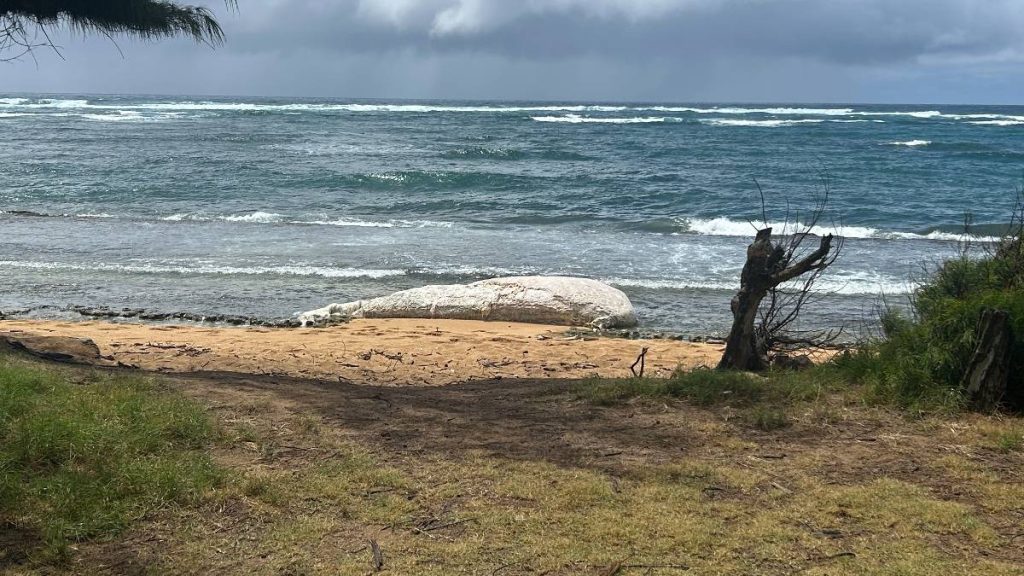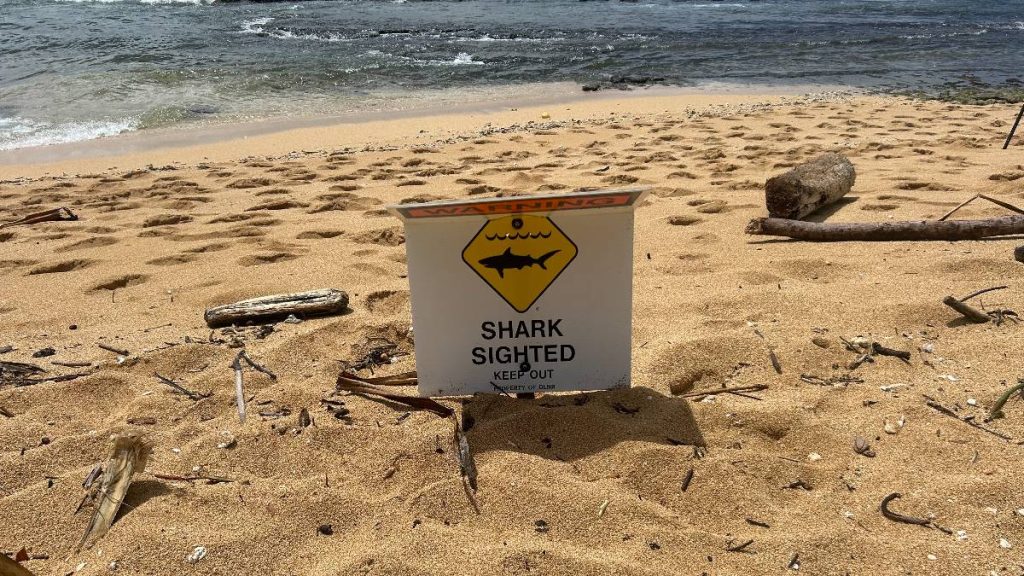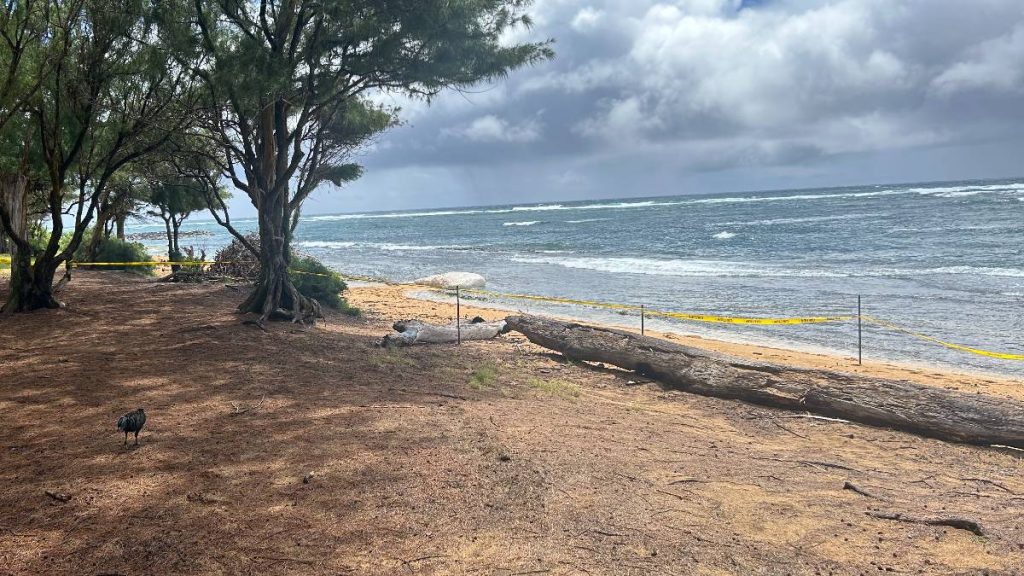Deprecated: stripslashes(): Passing null to parameter #1 ($string) of type string is deprecated in /mnt/efs/html/wp-content/plugins/template-scripts/src/AuthorBios/Frontend.php on line 129
Kapaʻa whale carcass originally planned to be left on shoreline will be buried
A cultural practitioner working with state environmental groups says there are now plans to bury the head of the decaying sperm whale that washed up on the shore outside the Sheraton Kauaʻi Coconut Beach Resort earlier this month, shifting from the initial decision to leave the carcass on the shoreline permanently.
“The smell isnʻt that bad, but the hotel managers and also the Bull Shed restaurant, they’ve had to move patrons of the restaurant to different rooms,” said Billy Kinney, a cultural practitioner from Hanalei who works with Kia’i Kanaloa, a multi-island network of Hawaiian cultural and religious practitioners who respond to reports of distressed and deceased marine mammals.
After first washing ashore by the resort on June 14, the state Department of Land and Natural Resources (DLNR) and National Oceanic and Atmospheric Administration (NOAA) consulted with Kia’i Kanaloa about whether to tow, bury, or leave the whale in place.
At the time, all parties agreed to leave the whale in place. Kinney explained the cultural and logistical reasons for the decision in a recent interview, noting that whales are revered in Hawaiian culture for representing the depths of the ocean and their abilities to bring about life through decomposition and regeneration.
“We believe when the whale comes to one place, or they arrive at a place, they came there for a reason. And so we should respect them and leave them there,” Kinney said, explaining that as the whale decomposes, it feeds crabs, fish, sharks, and other sea creatures in the area.
“So we believe that leaving it here is a way that this Kanaloa (Sea God) can feed this place and restore vitality to it,” he said.
Kinney said the decision was made on June 14 after inspecting the area in consultation with NOAA representative Jamie Thomton. They both agreed it would also be a challenge to tow the whale out to sea considering the weight of the carcass and the rocky, shallow area of the beach.
“Considering the viability of the different options and public safety, Jamie (Thomton) from NOAA and I kind of agreed that it would be feasible to let the whale rest here and stay here,” Kinney said on June 21.
However, at that time, Kinney added that if the whale continued to move, or if he began to hear reports of it bothering people, they would consider burying it.
“We also have to consider the smell,” he said at the time. “It might not be pleasant for people. So we will definitely consider that.”
Days later, on June 26, the whale had moved to the other side of the beach and was floating in the water just outside the ISO Hotel and the Bull Shed Restaurant.

The whale’s movement and reports from hotel guests and restaurant-goers of the carcass smelling caused NOAA to decide to bury the carcass, according to Kinney.
Kinney said the carcass will most likely be buried in nearby soil, but where the carcass goes needs to be carefully considered because there are also Native Hawaiian burials in the area.
The burials are mapped out through a previous archaeological study, said Kinney, which will be used to guide where the carcass is buried.
“As time goes on, and if it stays right in front of a business of course there’s going to be pressure to remove it,” said Kinney on June 26, noting he understood the decision for public safety.
“It would be beneficial to the place just to leave it and let it continue to do what it does in decomposition and feeding the place,” he said. But he emphasized they needed to be mindful of businesses and the public’s input.

On the afternoon of June 26, Kauaʻi Now ran into one born and raised Kauai resident who said he was disgusted by the fact that the carcass was still at the beach.
The resident, John, who declined to state his last name due to concerns of potential backlash from state employees, had been playing with his dog in the area where the whale had first washed ashore before realizing the carcass was still there — just floating further down the beach.
“It’s really nasty. I didn’t realize it was still here,” said John, who had walked down the beach to look at the carcass.
John was worried about the decomposing whale being toxic for people swimming in the area and disturbing both visitors and residents.
He noted he understood the cultural significance of whales in Hawai’i, saying that’s why the whale should be buried in the ground where it would safely disintegrate in nature.
“You don’t have to haul it somewhere else and make a special burial because if it’s in the ground, nature will do its work,” John said.
“But to just leave it near the restaurant?” he questioned. “We’re paying tax so we should have them dispose of it.”
He pointed to visitors who could be seen lying on pool chairs outside the ISO hotel, right by the decaying corpse. “Some people spend so many years just to come here on vacation,” John said, adding that it would likely be difficult to enjoy food and drinks sitting by the whale.
“People came to see real whales, alive whales, and healthy whales. Not some carcass that’s been here feeding on whatever’s out there, the sharks and whatever. But it’s just nasty,” he said.
“What are we waiting for?” he added, questioning the reason for government officials to have left it there for weeks.
Kaua’i Now also spoke with visitors Linda Cassady and Linette Moody from Washington state, both staying at the Sheraton Kaua’i Coconut Beach Resort, who were interested in taking a short walk down the beach to take a look at the carcass after hearing about a dead whale having washed ashore.

“I expected more of the carcass,” Cassady said, before realizing that it was only the whale’s head floating in the water.
However, both visitors said they did not notice its pungent smell and weren’t bothered by the carcass — just unsure why it had been left there.
“I kind of thought that they would come and clean it up and take it away. I’m wondering if they just leave it here to decompose or for other fish to eat up? I don’t know,” said Moody.

Cultural practitioner Kinney noted he is currently working to connect NOAA with lineal descendants of the area regarding the whale head carcass so that those connected to the area can have input about where it will be buried.
He said NOAA and the DLNR are working on a plan to get the necessary machinery and tools to bury the carcass, and that the whale will likely remain floating on the beach for at least one more week.
“The property owner is pretty gracious in giving us time to figure it out,” Kinney said. “They probably won’t make a move for another week. But still, another week where the whale can stay there and kind of contribute to the ecosystem.”
The decision to leave the whale in place for weeks followed the January 2023 burial of a dead sperm whale that washed up in Wailua, when it was dismembered, removed, and buried in a secret location. The incident was criticized by the nonprofit Kia’i Kanalola at the time.
“Our network was very critical of how it was handled by NOAA… It was not a pretty sight to witness,” Kinney said, emphasizing the sacredness of whales.
The group has since been more involved in handling marine mammal stranding incidents to provide cultural sensitivity and awareness for state organizations.
“How can science be respectful of this, and how can Hawaiian practice and religious practice accommodate the science,” Kinney said of their collaborative efforts.
Kaua’i Now contacted the DLNR to request confirmation that the whale would now be buried. However, DLNR Communications Director Dan Dennison was not aware of a plan to bury the whale and recommended contacting NOAA.
“NOAA is taking the lead on this stranding and we are in conversations with the owner of the resort, the Hawaiian community and others to make decisions of what to do next, leave in place or bury,” said Dennison in an email on June 27.
Kauaʻi Now has reached out to Stefanie Gutierrez, a communications specialist with NOAA, for further information about how the carcass will be handled.
Sponsored Content
Notice: Function the_widget was called incorrectly. Widgets need to be registered using
register_widget(), before they can be displayed. Please see Debugging in WordPress for more information. (This message was added in version 4.9.0.) in /mnt/efs/html/wp-includes/functions.php on line 6114
























